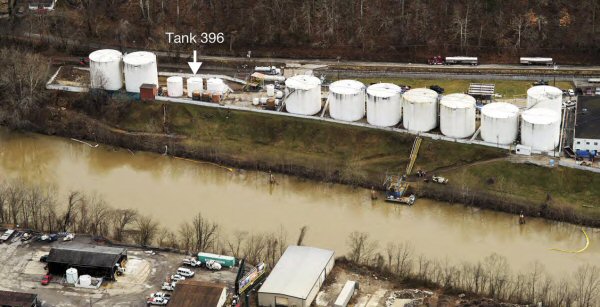SEJournal Online is the digital news magazine of the Society of Environmental Journalists. Learn more about SEJournal Online, including submission, subscription and advertising information.
Inside Story
|
|
|
This aerial photograph shows the Freedom Industries tank farm along the Elk River in Charleston, WV. The arrow identifies Tank 396, which leaked the coal-cleaning chemical Crude MCHM into the river on Jan. 9, 2014, contaminating the drinking water of 300,000 West Virginians for weeks. Photo: Commercial Photography Services of WV via U.S. Chemical Safety Board. |
Ken Ward Jr. is a staff reporter for the Charleston (WV) Gazette, and has been nationally recognized for his reporting on coal mining, the environment and workplace safety. Most recently he has been reporting on the Freedom Industries chemical spill in January2014 that left up to 300,000 people within nine West Virginia counties without access to drinking water. Ward spoke to SEJournal’s“Inside Story” editor Beth Daley about his work on the Freedom Industries spill story.
SEJournal: When you first heard of the Freedom Industries spill, who or what did you turn to first to report? Why? What came next?
Ken Ward Jr.: My first call was to a guy at our Department of Environmental Protection who handles emergency response, who is actually from my hometown and who I have known for years. He’s always good for a quick description of what appears to have happened and how the response is going. Hours later, when they announced the “do not use” the water order, I started trying to find out more about the chemical involved, “Crude MCHM,” by first circling back to my DEP source for a copy of the “material safety data sheet”or MSDS. Then I called some local toxicologists who had reviewed it to try to find out as much as I could on deadline about the potential effects of this chemical. It turned out that there just isn’t much known, as is the case for most chemicals used in our society.
SEJournal: It’s clear from your reporting you have developed critical sources you can rely on to fact-check what government and industry officials are saying – or not saying. How important was this in the Freedom spill and how did you develop those sources?
Ward: It’s always critical not to take the government’s word for anything. Like I.F. Stone said, “All governments lie.” In this instance, it was especially important to have outside sources and independent experts, because state and federal agencies were often not very cooperative in providing much-needed information to answer questions our neighbors had about their water supply. EPA and CDC were especially difficult to get answers from. In this case, I’ve covered local coal and chemical industries for a long time, so I have a decent collection of sources. I also reached out to several SEJ friends who were very helpful in providing specific experts on particular areas, like the development of a short-term screening level for how much MCHM was acceptable in water. Those sources helped us explain to our readers the kinds of unknowns, data gaps and other questions that existed about the CDC’s work on that screening level – absent CDC itself being willing to talk about those issues.
SEJournal: Your Coal Tattoo blog is considered a must-read for the public, industry and government. How do you cut through what can be emotion and rhetoric on both sides of the issue to get to the truth? What and who do you rely on?
Ward: I’m not sure that I do cut through the emotion and rhetoric. And I would say there’s absolutely nothing wrong with people being emotional about issues that affect both their health and safety and their ability to provide for their families. Journalists or government officials or industry lobbyists who pretend emotion has no place in these discussions are sending us down the wrong path in covering environmental stories. On my blog, I require everyone to be respectful of those they disagree with, and to provide links or citations to scientific articles or other sources to support their claims. These requirements have lost me many readers – who believe the Internet should be a place for them to pontificate without being held accountable for what they say. But I’d rather have a smaller group of commenters who provide a higher level of discussion. My blog doesn’t always get there, but I try to push it in that direction. I’m a very hands-on moderator of Coal Tattoo.
SEJournal: You’ve been quoted as saying when other reporters zig – covering a big mining disaster, for example – you zag. What do you mean by that? Can you give some examples?
Ward: I heard that at an IRE conference many years ago – I wish I could recall who said it first. It’s not my line. But for example, when the pack of journalists was chasing the Sago Mine Disaster story, my paper stepped back and wrote a project about how most coal miners who die on the job die alone, not in big disasters that get a lot of TV coverage. In the early days of the Freedom Industries spill, lots of folks were focused on the same old stories about the coal industry and lax regulation. I decided to focus more on the lack of emergency planning and accident prevention more broadly in all industries, and that produced some stories nobody else had.
SEJournal: You’ve written about the Appalachian Research Initiative for Environmental Science (ARIES) and its lack of transparency in disclosing its financial backing from the coal industry. What turned you onto that story and how did you pursue it? Do you ask questions of every study you read or report on?
Ward: I got into writing about ARIES because I heard a coal industry lobbyist praising it – and talking up his own involvement in the project – during a West Virginia Coal Association conference a few years ago. I’ve tried to pursue it by talking to the Virginia Tech folks, who were running the project, about their goals, and by keeping up with what papers are (and aren’t) published by researchers with ARIES funding. Journalists should be asking hard questions about every study they use in their reporting.
SEJournal: What advice can you give to environmental journalists just starting out in the field, knowing some may not be assigned to one specific industry or even beat?
Ward: Find a small, community-based and locally owned newspaper in your home state and work there. Avoid Washington and New York. Smaller communities need good journalism, and the stories you find will be much richer – so will your life. Think especially about reporting in and on the place you came from – a sense of place is all too rare in journalism these days. And try to stick around a while, so you can include a sense of history and context in your reporting. That’s not necessarily the popular career path these days, but I think it works.
Ward, 46, a native of Mineral County, WV, has worked at theGazette since 1991, and is the author of the popular Coal Tattoo, a blog on the mining industry. He has received numerous regional and national reporting awards, including being a three-time winner of the Scripps Howard Foundation’s Edward J. Meeman Award for Environmental Reporting and a medal from the Investigative Reporters and Editors organization. He’s covered the Upper Big Branch Mine, Sago and Darby Mine disasters and, in 2006, was an Alicia Patterson Fellow where he researched and reported on mining deaths. Ward was formerly long-time chairman of the Society of Environmental Journalists' Freedom of Information Task Force. Follow him at@Kenwardjr.
“Inside Story” editor Beth Daley is reporter and director of partnerships at the New England Center for Investigative Reporting, a nonprofit newsroom based at Boston University and affiliated with WGBH News.
|
|
|
State officials gathered for a news conference in early February where Dr. Tanja Popovic, director of the Centers for Disease Control and Prevention’s National Center for Environmental Health (at podium), joined EPA Regional Administrator Shawn Garvin and WV Gov. Earl Ray Tomblin (to her left) in trying to convince West Virginia residents that their water was safe from the coal-cleaning chemical Crude MCHM. Photo by Lawrence Pierce, Charleston (W.Va.) Gazette. |
* From the quarterly newsletter SEJournal, Spring 2014. Each new issue of SEJournal is available to members and subscribers only; find subscription information here or learn how to join SEJ. Past issues are archived for the public here.













 Advertisement
Advertisement 



